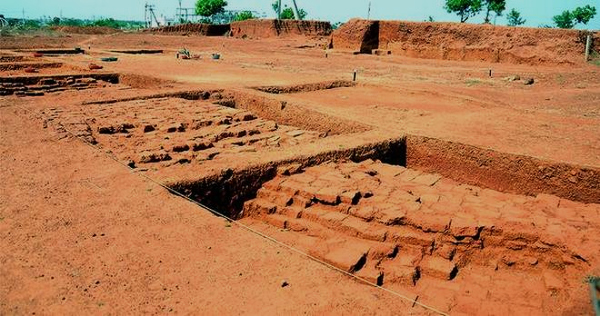The discovery of a 40-acre walled enclosure with artefacts at Gottiprolu near Naidupeta in Nellore district has come as a source of major encouragement for archaeologists and historians, who believe the area was a major maritime trade point in ancient days.
The recent findings would help corroborate theories pointing to a historic maritime past. Prominent among the findings are goblet-shaped vessels and conical jars which are worth mentioning as they are supposed to have been used by the elite. These were not used for cooking but were used to consume wine,” surmised Dr. Sreelakshmi, Superintending Archaeologist, Archaeological Survey of India, Excavation Branch VI, Bengaluru.
Dr. Sreelakshmi, a student of Prof. K.P. Rao, Department of History, University of Hyderabad (Central University), along with her team, made these discoveries while she was re-visiting the findings of Prof. Rao made during the early 1990s along the Swarnamukhi river. Prof. Rao made his first findings made when he was associated with S.V. University in 1993.
Unique discovery
“This particular site discovered with 6-ft-wide brick walls, structures and defence systems, is yielding new evidence on the Andhra region as earlier exploited sites in the South do not have evidence of such structures, which is very interesting,” said Prof. K.P. Rao.
“This probably indicates that it is a regional capital which is significant in terms of defence, maritime and economic activity. This place seems to have been culturally significant. We can say that the place must have played a vital role around the 1st and 2nd Century AD. This can be termed as a unique site in terms of archaeological evidence in South India,” he said.
The site, with 45 settlements, provides evidence to the theories proposed by experts at Arikamedu, Pondicherry, Sisupalgarh in Odisha and Kaveripatnam in Tamil Nadu where some artefacts related to maritime trade were found. However, Gottiprolu is a much bigger site and proves several literary and historical observations made by noted historians.
In fact, this is the first such excavation by the Bengaluru excavation branch in AP. Established in 2001, it carried out excavations at Kurugodu (Karnataka), Keeladi, Kodumanal (Tamil Nadu) where Neolithic settlements and elaborate structural remains of Sangam period were found.
Roman connection
A conical jar placed at the eastern side of the structure is an important find as such jars are widely distributed in Tamil Nadu and are considered to be an imitation of Roman Amphorae jars. A series of broken terracotta pipes fitted into one another found near this structure shed light on the civic amenities maintained by the occupants of this site. The most outstanding discovery so far made at the site is a massive brick structure that rises to a height of nearly 2 m and about 3.40 m in width.
The site of Gottiprolu lies on the right bank of a distributary of the Swarnamukhi, 17 km east of Naidupet and 80 km away from Tirupati and Nellore. The archaeological mound is known as ‘Kota Dibba’ (fortified mound).
Source: TH
Image Courtesy: The Hindu
You may also like
-
New Heat-Based Approach To Cancer Treatment Can Reduce Chemotherapy Doses
-
Scientists Take A Major Step Towards Unification Of Classical & Quantum Gravity
-
India Graphene Engineering and Innovation Centre (IGEIC) Under the Vision of Viksit Bharat@2047 Launched
-
New High-Performance Gas Sensor can Monitor Low Level Nitrogen Oxides Pollution
-
Antidepressant Drug can be Repurposed for Treating Breast Cancer
